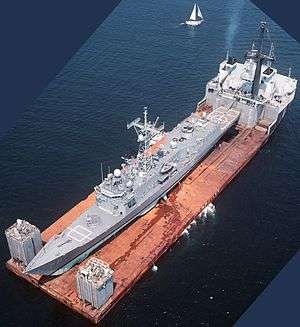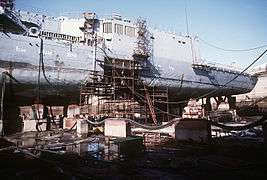USS Samuel B. Roberts (FFG-58)
_navigates_in_the_Caribbean_Sea_during_an_exercise.jpg) USS Samuel B. Roberts (FFG-58), navigates in the Caribbean Sea during an exercise, 9 April 2007. | |
| History | |
|---|---|
| Name: | Samuel B. Roberts |
| Namesake: | Coxswain Samuel B. Roberts |
| Awarded: | 22 March 1982 |
| Builder: | Bath Iron Works, Bath, Maine |
| Laid down: | 21 May 1984 |
| Launched: | 8 December 1984 |
| Sponsored by: | Mrs. Jack Yusen |
| Commissioned: | 12 April 1986 |
| Decommissioned: | 22 May 2015 |
| Homeport: | Mayport, Florida |
| Identification: |
|
| Motto: | "No Higher Honor" |
| Nickname(s): | "Sammy B" |
| Badge: |
 |
| General characteristics | |
| Class and type: | Oliver Hazard Perry-class frigate |
| Displacement: | 4,100 long tons (4,200 t), full load |
| Length: | 453 feet (138 m), overall |
| Beam: | 45 feet (14 m) |
| Draft: | 22 feet (6.7 m) |
| Propulsion: |
|
| Speed: | over 29 knots (54 km/h) |
| Range: | 5,000 nautical miles at 18 knots (9,300 km at 33 km/h) |
| Complement: | 15 officers and 190 enlisted, plus SH-60 LAMPS detachment of roughly six officer pilots and 15 enlisted maintainers |
| Sensors and processing systems: |
|
| Electronic warfare & decoys: | AN/SLQ-32; Mark 36 SRBOC |
| Armament: |
|
| Aircraft carried: | 2 × SH-60 LAMPS III helicopters |
| Aviation facilities: | |
USS Samuel B. Roberts (FFG-58) is one of the final ships in the United States Navy's Oliver Hazard Perry-class of guided missile frigates (FFG). Commissioned in 1986, the ship was severely damaged by an Iranian mine in 1988, leading U.S. forces to respond with Operation Praying Mantis. Repaired and returned to duty, the ship served until decommissioned in 2015.
Commissioning and namesake
The frigate was named for Samuel B. Roberts, a Navy coxswain who was killed while evacuating the U.S. Marines during the battle of Guadalcanal in 1942. Roberts was posthumously awarded the Navy Cross.
Samuel B. Roberts was the third U.S. ship to bear the coxswain's name, after Samuel B. Roberts (DE-413), a John C. Butler-class destroyer escort, commissioned in 1944 and sunk in the Battle off Samar later that year; and Samuel B. Roberts (DD-823), a Gearing-class destroyer, commissioned in 1946 and struck in 1970.
Samuel B. Roberts was launched in December 1984 by Bath Iron Works, Bath, Maine and sponsored by the wife of Jack Yusen, a member of DE-413's crew. The frigate was put in commission in April 1986 under the command of Commander Paul X. Rinn.
1988 deployment and mine strike
Samuel B. Roberts deployed from her home port in Newport, Rhode Island, in January 1988, heading for the Persian Gulf to participate in Operation Earnest Will, the escort of reflagged Kuwaiti tankers during the Iran–Iraq War. Samuel B. Roberts had arrived in the Persian Gulf and was heading for a refueling rendezvous with San Jose on 14 April when the ship struck an M-08 naval mine in the central Persian Gulf, an area she had safely transited a few days earlier. The mine blew a 15-foot (4.6 m) hole in the hull, flooded the engine room, and knocked the two gas turbines from their mounts. The blast also broke the keel of the ship; such structural damage is almost always fatal to most vessels. The crew fought fire and flooding for five hours and saved the ship. Among other steps, sailors cinched cables on the cracked superstructure in an effort to stabilize it.[1] She used her auxiliary thrusters to get out of the mine field at 5 kn (5.8 mph; 9.3 km/h). According to How We Fight, by the US Naval War College, the ship never lost combat capability with her radars and Mk13 missile launcher.[2] However, according to No Higher Honor by Bradley Peniston, the ship lost power for at least five minutes. After power was lost, the radars were disconnected to allow restoration of the power grid. The ship lost track of an Sa'am frigate and an Iranian P-3 that it had been monitoring.[3] Ten sailors were medevaced by HC-5 CH-46s embarked on San Jose for injuries sustained in the blast; six returned to Samuel B. Roberts in a day or so. Four burn victims were sent for treatment to a military hospital in Germany, and eventually to medical facilities in the United States.[4]
When U.S. divers recovered several unexploded mines, they found that their serial numbers matched the sequence on mines seized the previous September aboard an Iranian mine-layer named Iran Ajr. Four days later, U.S. forces retaliated against Iran in Operation Praying Mantis, a one-day campaign that was the largest American surface engagement since World War II.[5] U.S. ships, aircraft, and troops destroyed two Iranian oil platforms allegedly used to control Iranian naval forces in the Persian Gulf, sank one Iranian frigate, damaged another, and sent at least three armed high-speed boats to the bottom. The U.S. lost one Marine helicopter and its crew of two airmen in what appeared to be a night maneuver accident rather than a result of hostile operations.
Repairs
On 27 June 1988, Samuel B. Roberts was loaded onto Mighty Servant 2, a semi-submersible heavy lift ship owned by Dutch shipping firm Wijsmuller Transport and carried back to Newport for $1.3 million.[6] The frigate arrived at BIW's Portland, Maine, yard on 6 October 1988 for repairs. The repair job was unique: the entire engine room was cut out of the hull, and a 315-ton replacement module was jacked up and welded into place.[7] She undocked 1 April 1989 for sea trials.
The repairs were completed three weeks ahead of schedule at a cost of $89.5 million, $3.5 million less than expected.[1] By comparison, Princeton, which was damaged by a moored mine during the 1991 Gulf War, was repaired for $24 million;[8] however, the cruiser was not directly struck by the mine and her displacement is nearly twice that of Samuel B. Roberts. The mine that nearly sank Samuel B. Roberts had an estimated cost of $1,500.[8]
After 13 months of repairs, Samuel B. Roberts was returned to service in a 16 October 1989 ceremony.
After repair
Samuel B. Roberts made her second deployment in 1990 for Operation Desert Storm and Operation Desert Shield. The frigate operated as part of the Red Sea Maritime Interception Force, an international force of ships that enforced U.N. sanctions against Iraq. The frigate's sailors boarded more than 100 merchant ships in efforts to prevent cargo shipments to or from Iraq.[9] On 28 March 1991, she returned to Newport.
"Sammy B", as the ship is sometimes called, was later homeported in Mayport, Florida.
On 30 August 1991, Joseph A. Sestak took command of Samuel B. Roberts, which was named the Atlantic Fleet's best surface combatant in the 1993 Battenberg Cup competition.
Samuel B. Roberts was decommissioned at Mayport on 22 May 2015,[10] then towed to the Naval Inactive Ship Maintenance Facility in Philadelphia. The ship is slated to be dismantled.[11]
Gallery
 MV Mighty Servant 2 carrying mine-damaged Samuel B. Roberts on 31 July 1988
MV Mighty Servant 2 carrying mine-damaged Samuel B. Roberts on 31 July 1988 Samuel B. Roberts in a dry dock in Dubai, UAE for temporary repairs.
Samuel B. Roberts in a dry dock in Dubai, UAE for temporary repairs. Samuel B. Roberts damaged hull.
Samuel B. Roberts damaged hull.
References
- 1 2 Peniston, Bradley (2006). No Higher Honor: Saving the USS Samuel B. Roberts in the Persian Gulf. Annapolis: Naval Institute Press. ISBN 1-59114-661-5.
- ↑ Naval War College, United States. Navy (Oct 15, 2015). How We Fight: Handbook for the Naval Warfighter (1 ed.). Chapter 2: Government Printing Office. p. 42. ISBN 978-1-935352-41-9. Retrieved 27 September 2016.
- ↑ Peniston, Bradley (2006). No Higher Honor: Saving the USS Samuel B. Roberts in the Persian Gulf. Annapolis: Naval Institute Press. p. 132. ISBN 1-59114-661-5.
"Rinn donned sound powered phones and called Palmer in CIC. "How are my combat systems? What have we got?" The answer came back: "We got nothing, really. No surface search radar, no radios." The captain told the combat systems officer to cut the radar out of the ship's power system so that it wouldn't drag on the grid as the engineers worked to bring it back up. ... Still, this turned the frigate from a sitting duck into a deaf and blind one.
- ↑ Liewer, Steve, "Teamwork Saved Stricken Warship", San Diego Union-Tribune, 19 April 2008.
- ↑ Love, Robert William. History of the U.S. Navy. Harrisburg: Stackpole Books, 1992. ISBN 0-8117-1863-8 p. 787
- ↑ "NO HIGHER HONOR: Timeline". Navybook.com. Retrieved 19 May 2011.
- ↑ "NO HIGHER HONOR: Photos: FFG 58 under repair at Bath Iron Works". Navybook.com. Retrieved 19 May 2011.
- 1 2 Annati
- ↑ "(Pd-Usn)". History.navy.mil. Retrieved 19 May 2011.
- ↑ Peniston, Bradley (May 23, 2015). "The Once—and Future?—USS Samuel B. Roberts". Defense One. Retrieved May 30, 2015.
- ↑ "SEAPOWER Magazine Online". seapowermagazine.org. Retrieved 13 August 2014.
Annati, Massimo Al diavolo le mine RID magazine, Coop. Riviera Ligure, Italy, n. 6/2005 This article incorporates text from the public domain Dictionary of American Naval Fighting Ships. The entry can be found here. This article includes information collected from the Naval Vessel Register, which, as a U.S. government publication, is in the public domain. The entry can be found here.
Further reading
- Peniston, Bradley (2006). No Higher Honor: Saving the USS Samuel B. Roberts in the Persian Gulf. Annapolis: Naval Institute Press. ISBN 1-59114-661-5.
- Wise, Harold Lee (2007). Inside the Danger Zone: The U.S. Military in the Persian Gulf 1987–88. Annapolis: Naval Institute Press. ISBN 1-59114-970-3.
External links
| Wikimedia Commons has media related to USS Samuel B. Roberts (FFG-58). |
- USS Samuel B. Roberts official site
- Photo gallery of USS Samuel B. Roberts (FFG-58) at NavSource Naval History
- Samuel B. Roberts narrative and timeline
- Photos of Samuel B. Roberts during February 1986 sea trials
- Photos of Samuel B. Roberts being commissioned in April 1986
- Photos of Samuel B. Roberts being hauled from the Persian Gulf to Newport, R.I. aboard Mighty Servant 2 in 1988
- MaritimeQuest USS Samuel B. Roberts FFG-58 pages